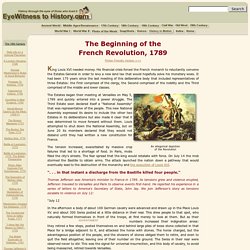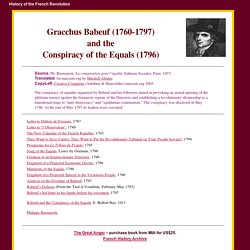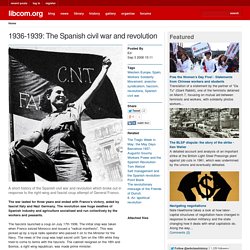

InstaGrok on the Russian Revolution. Causes - The History of Activism. War and Revolution. Alexander Palace Time Machine. The Russian Revolution - Part 1. The Russian Revolution - Part 2. The Russian Revolution - Part 3. Causes of the October Revolution. Russian Revolution / Spark Notes. Russian Revolution. The February Revolution (known as such because of Russia’s use of the Julian calendar until February 1918) began on March 8, 1917 (or February 23 on the Julian calendar), when demonstrators clamoring for bread took to the streets in the Russian capital of Petrograd (now called St.

Petersburg). Supported by huge crowds of striking industrial workers, the protesters clashed with police but refused to leave the streets. On March 10, the strike spread among all of Petrograd’s workers, and irate mobs destroyed police stations. Mobento. War and Revolution. The Beginning of the French Revolution. The Beginning of the French Revolution, 1789 King Louis XVI needed money.

His financial crisis forced the French monarch to reluctantly convene the Estates General in order to levy a new land tax that would hopefully solve his monetary woes. It had been 175 years since the last meeting of this deliberative body that included representatives of three Estates: the First comprised of the clergy, the Second comprised of the nobility and the Third comprised of the middle and lower classes. The Estates began their meeting at Versailles on May 5, 1789 and quickly entered into a power struggle. The tension increased, exacerbated by massive crop failures that led to a shortage of food. Thomas Jefferson was America's minister to France in 1789. "July 12 In the afternoon a body of about 100 German cavalry were advanced and drawn up in the Place Louis XV. and about 300 Swiss posted at a little distance in their rear.
July 13. French Revolution / Spark Notes. French Revolution. French Revolution, also called Revolution of 1789, the revolutionary movement that shook France between 1787 and 1799 and reached its first climax there in 1789.

Hence the conventional term “Revolution of 1789,” denoting the end of the ancien régime in France and serving also to distinguish that event from the later French revolutions of 1830 and 1848. Origins of the Revolution The French Revolution had general causes common to all the revolutions of the West at the end of the 18th century and particular causes that explain why it was by far the most violent and the most universally significant of these revolutions. The first of the general causes was the social structure of the West. The feudal regime had been weakened step-by-step and had already disappeared in parts of Europe. A larger population created a greater demand for food and consumer goods. It is uncertain, however, whether revolution would have come without the added presence of a political crisis.
EPIC Databases. Liberty, Equality, Fraternity. French Revolution. Gracchus Babeuf / Conspiracy of the Equals. Source: Ph.

Buonarroti. La conspiration pour l’égalité, Editions Sociales, Paris. 1957;Translated: for marxists.org by Mitchell Abidor;CopyLeft: Creative Commons (Attribute & ShareAlike) marxists.org 2005. The conspiracy of equality organised by Babeuf and his followers aimed at provoking an armed uprising of the plebeian masses against the bourgeois regime of the Directory and establishing a revolutionary dictatorship as a transitional stage to “pure democracy” and “egalitarian communism.”
The conspiracy was disclosed in May 1796. At the end of May 1797 its leaders were executed. Letter to Dubois de Fosseux, 1787Letter to “l’Observateur”, 1789The New Calendar of the French Republic, 1793They Want to Save Carrier; They Want to Put the Revolutionary Tribunal on Trial. Spanish Revolution. A short history of the Spanish civil war and revolution which broke out in response to the right-wing and fascist coup attempt of General Franco.

The war lasted for three years and ended with Franco's victory, aided by fascist Italy and Nazi Germany. The revolution saw huge swathes of Spanish industry and agriculture socialised and run collectively by the workers and peasants. The fascists launched a coup on July 17th 1936. The initial step was taken when Franco seized Morocco and issued a "radical manifesto". This was picked up by a loyal radio operator who passed it on to the Minister for the Navy. Spanish Revolution. See Jamal Hannah's Spain pages, and Archie Anderson's account of the November 1996 reunion.

Eugene W. Plawiuk's extraordinarily well-linked site on Spain. When Franco's fascist troops invaded Spain in July 1936 with the purpose of overthrowing the young and unstable Republic, the Spanish working class responded by making a revolution that went much further toward realizing the classless and stateless ideal of proletarian socialism than any preceding popular revolt. Spontaneously and almost overnight, workers seized factories and other workplaces; land was collectivized; workers' militias were formed throughout the country; the church--age-old enemy of all workingclass radicalism and indeed, openly profascist--was dismantled, and its property confiscated; established political institutions disintegrated or were taken over by workers' committees. When fascism emerged triumphant in Spain in 1939, many Spanish revolutionaries sought political asylum in the United States.
The Spanish Civil War. Summary On April 14, 1931 the Spanish monarchy was declared overthrown and a provisional government took power.

Spanish Revolution. Sam Dolgoff estimated that about eight million people participated directly or at least indirectly in the Spanish Revolution,[1] which he claimed "came closer to realizing the ideal of the free stateless society on a vast scale than any other revolution in history.

"[2] Dolgoff quotes the French anarchist historian Gaston Leval (who was an active participant) to summarize the anarchist conception of the social revolution:[3] In Spain during almost three years, despite a civil war that took a million lives, despite the opposition of the political parties (republicans, left and right Catalan separatists, socialists, Communists, Basque and Valencian regionalists, petty bourgeoisie, etc.), this idea of libertarian communism was put into effect. Very quickly more than 60% of the land was collectively cultivated by the peasants themselves, without landlords, without bosses, and without instituting capitalist competition to spur production. Orwell's account[edit] Social revolution[edit]
Spanish Revolution Archive. Cuban Revolution. The Cuban Revolution (1953–1959) was an armed revolt conducted by Fidel Castro's 26th of July Movement and its allies against the US-backed authoritarian government of Cuban President Fulgencio Batista.

The revolution began in July 1953,[4] and continued sporadically until the rebels finally ousted Batista on 1 January 1959, replacing his government with a revolutionary socialist state. The Movement organization later reformed along communist lines, becoming the Communist Party in October 1965.[5] The Communist Party, now headed by Castro's brother Raúl, continues to govern Cuba today. The Cuban Revolution had powerful domestic and international repercussions. Background and causes[edit] Early stages[edit] The people, including Fidel and Raúl Castro, were captured shortly afterwards. Cuban Revolution. Essay published under the title “The Cuban Revolution,” Manuel R. and Teresita P.

Moreno-Fraginals, “The Cuban Revolution” International Encyclopedia of the Social and Behavioral Sciences, Neil J.Smelser .Ed. (London: Pergamon, 2001). The Cuban Revolution, as Fidel Castro proclaimed in January 1959, was a true revolution. Castro and the Cuban Revolution / Video. The Cuban Revolution. In the final days of 1958, ragged rebels began the process of driving out forces loyal to Cuban dictator Fulgencio Batista. By New Year’s Day, the nation was theirs, and Fidel Castro, Ché Guevara, Raúl Castro, Camilo Cienfuegos and their companions rode triumphantly into Havana and history. The revolution began long before, however, and the eventual rebel triumph was the result of many years of hardship, guerrilla warfare and propaganda battles.
Batista Seizes Power: The revolution began in 1952, when former army Sergeant Fulgencio Batista seized power during a hotly contested election. Batista had been president from 1940-1944 and ran for president in 1952. Ethiopian Civil War. The politics and history behind the genocide in Ethiopia are both complex and cyclical. They resulted from a civil war and successive famines, as the coup d’etat which ignited the civil war was preceded by a severe bout of famine from 1972 to 1973. Emperor Haile Selassie I’s response to the famine was dismissive, claiming that it was merely a natural disaster.
However, seeing the famine as the result of governmental indifference and as a crime against humanity, the Ethiopian public became quite discontented with Selassie’s rule. Amidst such unrest, the Dergue, a Marxist military junta led by Mengistu Haile Mariam, emerged and eventually staged a coup d’etat that ended in Selaisse’s assassination. Because the Dergue presented a chance for change in the relationships between Ethiopia’s leaders and its peasantry, junta rule was at first seen as beneficial. Mengistu Haile Mariam- Photo courtesy of Wikimedia Commons.
Mexican Revolution. Mexican Revolution, (1910–20), a long and bloody struggle among several factions in constantly shifting alliances which resulted ultimately in the end of the 30-year dictatorship in Mexico and the establishment of a constitutional republic. The revolution began against a background of widespread dissatisfaction with the elitist and oligarchical policies of Porfirio Díaz that favoured wealthy landowners and industrialists.
When Díaz in 1908 said that he welcomed the democratization of Mexican political life and appeared ambivalent about running for his seventh reelection as president in 1910, Francisco Madero emerged as the leader of the Antireeleccionistas and announced his candidacy. Díaz had him arrested ... (100 of 933 words) <ul><li><a href="/EBchecked/media/88100/The-Trench-mural-by-Jose-Clemente-Orozco-depicting-soldiers-fighting?